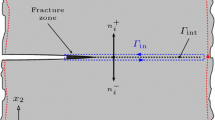Abstract
A theory of viscoelastic crack growth developed nearly five decades ago is generalized to express traction in the so-called fracture process zone or failure zone as a function of the crack opening displacement (COD). In earlier work, except for minor exceptions, traction was specified as a function of location. The new model leads to a nonlinear double integral equation that has to be solved for the COD before crack growth can be predicted. First, a closed-form, accurate approximation is found for a linear elastic body. We then show that this COD may be easily and accurately extended to linear viscoelasticity using a realistic, broad spectrum creep compliance. An analytical relationship connecting the stress intensity factor to crack speed then follows. Consistent with earlier work, it is defined almost entirely by creep compliance. Five different failure zone tractions are employed; their differences are shown to have little effect on crack growth other than through a speed shift factor. The Appendix discusses initiation of growth.












Similar content being viewed by others
References
Anderson TL (2017) Fracture mechanics: fundamentals and applications, 4th edn. CRC Press, Boca Raton
Barenblatt GI (1962) The mathematical theory of equilibrium cracks in brittle fracture. Adv Appl Mech VII:55–129
Brockway GS, Schapery RA (1978) Some viscoelastic crack growth relations for orthotropic and prestrained media. Eng Fract Mech 10:453–468
Ciavarella M (2020) Politecnico di Bari, Private communication
Dugdale DS (1960) Yielding of sheet steel containing slits. J Mech Phys 8:100–104
Greenwood JA (2004) The theory of viscoelastic crack propagation and healing. J Phys D: Appl Phys 37:2557–2569
Greenwood JA (2007) Viscoelastic crack propagation and closing with Lennard-Jones surface forces. J Phys D: Appl Phys 40:1769–1777
Greenwood JA, Johnson KL (1981) The mechanics of adhesion of viscoelastic solids. Philos Mag 43:697–711
Kaminsky A (2014) Mechanics of the delayed fracture of viscoelastic bodies with cracks: Theory and experiment (review). Int Appl Mech 50:485–548
Knauss WG (2015) A review of fracture in viscoelastic materials. Int J Fract 196:99–146
Morishita Y, Tsunoda K, Urayama K (2016) Velocity transition in the crack growth dynamics of filled elastomers: contributions of nonlinear viscoelasticity. Phys Rev E93:043001
Mueller HK, Knauss WG (1971) Crack propagation in a linearly viscoelastic strip. J Appl Mech 38E:483–488
Rodriguez P, Mangiagalli P, Persson NJ (2020) Viscoelastic crack propagation: Review of theories and applications. Adv Polym Sci 286:377–420
Schapery RA (1965) A method of viscoelastic stress analysis using elastic solutions. J Franklin Inst 279:268–289
Schapery RA (1967) Stress analysis of viscoelastic composite materials. J Comp Mat 1:228–267
Schapery RA (1973) A theory of crack growth in viscoelastic media. Texas A&M Report MM2764-73-1. NTIS AD 759379
Schapery RA (1975a) A theory of crack initiation and growth in viscoelastic media. Part I: theoretical development. Int J Fract 11:141–159
Schapery RA (1975b) A theory of crack initiation and growth in viscoelastic media. Part II: approximate methods of analysis. Int J Fract 11:369–388
Schapery RA (1975c) A theory of crack initiation and growth in viscoelastic media, Part III: Analysis of continuous growth. Int J Fract 11:549–562
Schapery RA (1984) Correspondence principles and a generalized J integral for large deformation and fracture analysis of viscoelastic media. Int J Fract 25:195–223
Schapery RA (1990) On some path independent integrals and their use in fracture of nonlinear viscoelastic media. Int J Fract 42:189–207
Schapery RA (2020a) A model for the prediction of rubber friction with Schallamach waves. Trib Int 143:106018
Schapery RA (2020b) The effect of global viscoelasticity on rubber friction with Schallamach waves. Trib Int 148:106306
Schapery RA (2021) Stable and unstable viscoelastic crack growth-experimental validation of nonlinear theory (submitted for publication)
Acknowledgements
The author wishes to express his thanks to Prof. Ciavarella for helpful suggestions on the manuscript and encouraging me to return to the subject topic and study the possibility of solving the problem when the FZ traction is not specified a priori; but instead depends on the crack opening displacement. The reviewer’s many helpful comments are also greatly appreciated.
Author information
Authors and Affiliations
Corresponding author
Additional information
Publisher's Note
Springer Nature remains neutral with regard to jurisdictional claims in published maps and institutional affiliations.
Rights and permissions
About this article
Cite this article
Schapery, R.A. A theory of viscoelastic crack growth: revisited. Int J Fract 233, 1–16 (2022). https://doi.org/10.1007/s10704-021-00605-z
Received:
Accepted:
Published:
Issue Date:
DOI: https://doi.org/10.1007/s10704-021-00605-z




